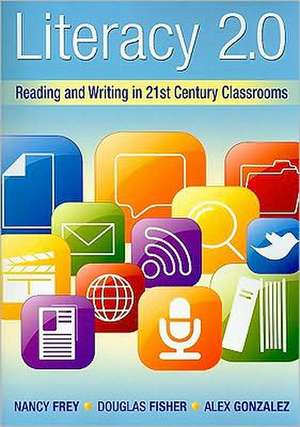Literacy 2.0: Reading and Writing in 21st Century Classrooms
Autor Nancy Frey, Douglas Fisher, Alex Gonzalezen Limba Engleză Paperback – 31 mai 2010
Preț: 197.32 lei
Nou
Puncte Express: 296
Preț estimativ în valută:
37.76€ • 39.28$ • 31.17£
37.76€ • 39.28$ • 31.17£
Carte indisponibilă temporar
Doresc să fiu notificat când acest titlu va fi disponibil:
Se trimite...
Preluare comenzi: 021 569.72.76
Specificații
ISBN-13: 9781935249801
ISBN-10: 1935249800
Pagini: 141
Dimensiuni: 175 x 249 x 13 mm
Greutate: 0.32 kg
Editura: Solution Tree
ISBN-10: 1935249800
Pagini: 141
Dimensiuni: 175 x 249 x 13 mm
Greutate: 0.32 kg
Editura: Solution Tree
Descriere
Literacy 2.0 is where traditional literacy and technological literacy meet. Students in the 21st century still need to develop the reading and writing skills that were the aim of literacy 1.0 instruction, but they must go beyond those skills and learn how to use technology for communicating and collaborating in new ways. Constantly evolving technologies and new 21st century frameworks for what students should know and be able to do present great challenges for today s teachers. In this book, Nancy Frey, Douglas Fisher, and Alex Gonzalez offer readers the benefit of their own extensive experience in secondary literacy 2.0 classrooms. They describe precisely what students need to be taught to become proficient in the literacies associated with information and communication technologies. They begin by presenting a general instructional model that is particularly effective in supporting this type of learning. Then they move on to the specifics of teaching the literacy 2.0 skills related to acquiring, producing, and sharing information. These skills include using search engines efficiently, evaluating information found on websites, avoiding plagiarism, communicating with a wide audience, working collaboratively, and creating multimedia products. In a highly accessible style, the authors explain in detail how to use the many tools and technologies they discuss and give numerous suggestions for classroom applications. Teachers who are not familiar with the tools will learn enough to gain the confidence to try using them, and those who are more experienced will find new ideas to introduce in their classrooms. All readers will gain a greater appreciation for the power of technology to engage and motivate students and will be inspired by the examples of high-level student work.
